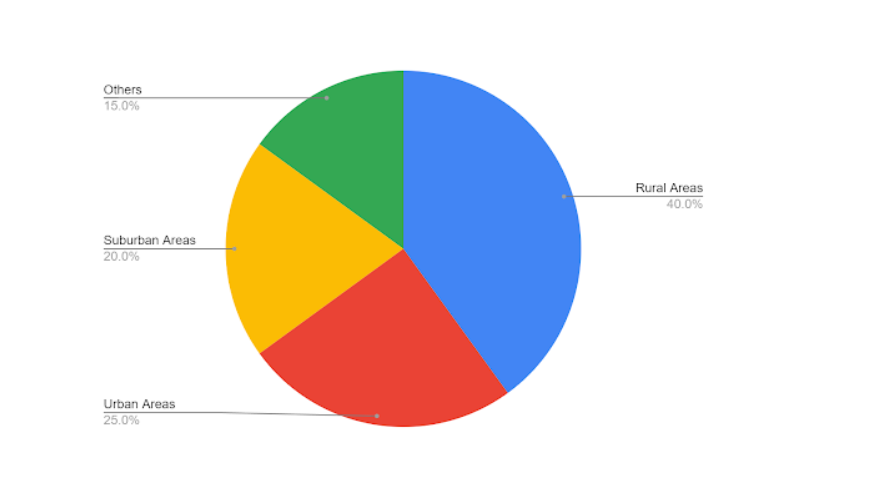
In recent years, telemedicine has emerged as a transformative force in the healthcare industry, particularly for rural areas where access to medical services has historically been limited. With the integration of internet technology, telemedicine is revolutionizing rural healthcare, providing patients with unprecedented access to quality medical care, no matter their location.
Read our article : https://dreamstechnologies.com/telehealth-vs-telemedicine-vs-telecare-key-differences/
Bridging the Gap in Rural Healthcare


One of the most significant challenges in rural healthcare has been the geographical barriers that prevent residents from accessing timely medical services. Traditional healthcare delivery models often require patients to travel long distances to see a specialist or receive treatment. This delay can be critical, especially in cases where immediate medical attention is necessary. Telemedicine, powered by robust internet technology, is effectively bridging this gap. Telehealth services enable patients in remote areas to connect with healthcare providers through virtual health consultations, eliminating the need for long journeys. Patients can now receive expert medical advice from the comfort of their homes, significantly improving the quality and timeliness of care.
The Role of Internet Technology in Telemedicine
The success of telemedicine in rural areas is largely due to advancements in digital healthcare solutions and the Internet of Medical Things (IoMT). These technologies allow for remote patient monitoring, where devices connected to the internet can track vital signs, glucose levels, heart rate, and other critical health metrics in real-time. This data is then transmitted securely to healthcare providers, enabling them to make informed decisions without the patient needing to visit a clinic. Additionally, cloud-based telemedicine platforms have made it easier to store and manage Electronic Health Records (EHR). This ensures that patient data is readily available and can be accessed by authorized medical personnel across various locations, enhancing the continuity of care.
Expanding Access with Telehealth Platforms
The development of telehealth platforms has been a game-changer for rural healthcare. These platforms, supported by secure healthcare information systems, provide a seamless experience for both patients and providers. From scheduling appointments to conducting virtual consultations and managing online medical prescriptions, these platforms offer comprehensive digital healthcare solutions. Moreover, the digital health ecosystem ensures that even in areas with limited internet connectivity, healthcare services remain accessible. For instance, low-bandwidth solutions are being developed to cater to rural areas where internet infrastructure is still developing.
https://dreamstechnologies.com/enhancing-mental-healthcare-benefits-of-teleconsultation/
Security and Compliance in Rural Telemedicine
With the increased reliance on internet technology, ensuring the security and privacy of patient data has become paramount. Telemedicine platforms must adhere to stringent compliance and security standards to protect sensitive health information. The use of secure health data transmission methods is crucial in maintaining the trust of rural populations who might be wary of digital healthcare solutions.
A Promising Future for Rural Healthcare
The integration of internet technology in telemedicine is just the beginning. As telemedicine infrastructure continues to evolve, we can expect further innovations that will enhance the delivery of healthcare in rural areas. From real-time health data analysis to the expansion of telemedicine software solutions, the future looks promising for rural healthcare.
Expanding Access with Telehealth Platforms
The development of telehealth platforms has been a game-changer for rural healthcare. These platforms, supported by secure healthcare information systems, provide a seamless experience for both patients and providers. From scheduling appointments to conducting virtual consultations and managing online medical prescriptions, these platforms offer comprehensive digital healthcare solutions. Moreover, the digital health ecosystem ensures that even in areas with limited internet connectivity, healthcare services remain accessible. For instance, low-bandwidth solutions are being developed to cater to rural areas where internet infrastructure is still developing.
Security and Compliance in Rural Telemedicine
With the increased reliance on internet technology, ensuring the security and privacy of patient data has become paramount. Telemedicine platforms must adhere to stringent compliance and security standards to protect sensitive health information. The use of secure health data transmission methods is crucial in maintaining the trust of rural populations who might be wary of digital healthcare solutions.
Challenges Faced in Implementing Telemedicine
![]() Inadequate Infrastructure: Many rural areas lack sufficient internet connectivity, which can limit the effectiveness of telemedicine services.
Inadequate Infrastructure: Many rural areas lack sufficient internet connectivity, which can limit the effectiveness of telemedicine services.
![]() Resistance to Technology: Older populations, in particular, may resist adopting new digital tools, making it difficult to implement telemedicine effectively.
Resistance to Technology: Older populations, in particular, may resist adopting new digital tools, making it difficult to implement telemedicine effectively.
![]() High Implementation Costs: The cost of implementing telemedicine solutions can be prohibitive for some rural healthcare providers, making affordability and scalability crucial.
High Implementation Costs: The cost of implementing telemedicine solutions can be prohibitive for some rural healthcare providers, making affordability and scalability crucial.
![]() Digital Divide: Limited access to necessary devices and internet connections among some populations remains a significant barrier to telemedicine adoption.
Digital Divide: Limited access to necessary devices and internet connections among some populations remains a significant barrier to telemedicine adoption.

Introducing Doccure’s Approach
To overcome these challenges, Doccure has developed an IoT-integrated approach to telemedicine that is specifically designed for rural healthcare settings. By leveraging IoT devices, Doccure’s platform allows for continuous remote patient monitoring, even in areas with limited connectivity. Doccure’s telemedicine solutions are also designed to be user-friendly, ensuring that patients of all ages can easily access the care they need. Doccure’s approach includes customizable telehealth platforms that cater to the unique needs of rural healthcare providers. These platforms are equipped with low-bandwidth features, ensuring that even those with limited internet access can benefit from telemedicine services. Additionally, Doccure offers scalable solutions that can grow with the needs of the healthcare provider, making telemedicine more accessible and sustainable for rural communities.
A Promising Future for Rural Healthcare
The integration of internet technology in telemedicine is just the beginning. As telemedicine infrastructure continues to evolve, we can expect further innovations that will enhance the delivery of healthcare in rural areas. From real-time health data analysis to the expansion of telemedicine software solutions, the future looks promising for rural healthcare.
Conclusion
Telemedicine, empowered by internet technology, is ushering in a new era of healthcare accessibility for rural communities. By leveraging digital health technologies, rural patients can now receive the care they need, when they need it, regardless of their location. This shift is not just improving health outcomes; it’s also transforming the very fabric of rural healthcare delivery.
Get in touch for a Demo.
Email: [email protected], Call Us: UK: +44-9438-823485 / IN: +91-96000-08844
